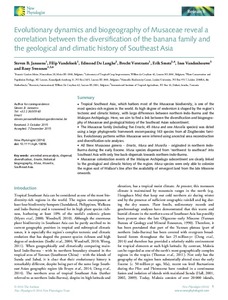| dc.contributor.author | Janssens, S.B. |
| dc.contributor.author | Vandelook, F. |
| dc.contributor.author | Langhe, E. de |
| dc.contributor.author | Verstraete, B. |
| dc.contributor.author | Smets, E. |
| dc.contributor.author | Vandenhouwe, I. |
| dc.contributor.author | Swennen, R.L. |
| dc.contributor.author | Vandelook, F |
| dc.date.accessioned | 2019-12-04T10:57:28Z |
| dc.date.available | 2019-12-04T10:57:28Z |
| dc.date.issued | 2016 |
| dc.identifier.citation | Janssens, S., De Langhe, E., Verstraete, B., Smets, E. & Swennen, R. (2016). Evolutionary dynamics and biogeography of Musaceae reveal a correlation between the diversification of the banana family and the geological and climatic history of Southeast Asia. New Phytologist, 1-13. |
| dc.identifier.issn | 0028-646X |
| dc.identifier.uri | https://hdl.handle.net/20.500.12478/749 |
| dc.description | Article Purchased |
| dc.description.abstract | Tropical Southeast Asia, which harbors most of the Musaceae biodiversity, is one of the most species-rich regions in the world. Its high degree of endemism is shaped by the region's tectonic and climatic history, with large differences between northern Indo-Burma and the Malayan Archipelago. Here, we aim to find a link between the diversification and biogeography of Musaceae and geological history of the Southeast Asian subcontinent. The Musaceae family (including five Ensete, 45 Musa and one Musella species) was dated using a large phylogenetic framework encompassing 163 species from all Zingiberales families. Evolutionary patterns within Musaceae were inferred using ancestral area reconstruction and diversification rate analyses. All three Musaceae genera - Ensete, Musa and Musella - originated in northern Indo-Burma during the early Eocene. Musa species dispersed from 'northwest to southeast' into Southeast Asia with only few back-dispersals towards northern Indo-Burma. Musaceae colonization events of the Malayan Archipelago subcontinent are clearly linked to the geological and climatic history of the region. Musa species were only able to colonize the region east of Wallace's line after the availability of emergent land from the late Miocene onwards. |
| dc.format.extent | 1-13 |
| dc.language.iso | en |
| dc.subject | Diversification |
| dc.subject | Musa |
| dc.subject | Biogeography |
| dc.subject | Southeast Asia |
| dc.subject | Musaceae |
| dc.subject | Bananas |
| dc.title | Evolutionary dynamics and biogeography of Musaceae reveal a correlation between the diversification of the banana family and the geological and climatic history of Southeast Asia |
| dc.type | Journal Article |
| dc.description.version | Peer Review |
| cg.contributor.crp | Roots, Tubers and Bananas |
| cg.contributor.affiliation | Botanic Garden Meise, Belgium |
| cg.contributor.affiliation | Laboratory of Tropical Crop Improvement, Belgium |
| cg.contributor.affiliation | Plant Conservation and Population Biology, Belgium |
| cg.contributor.affiliation | Leiden University |
| cg.contributor.affiliation | Bioversity International |
| cg.contributor.affiliation | International Institute of Tropical Agriculture |
| cg.coverage.region | Asia |
| cg.coverage.region | Southeast Asia |
| cg.isijournal | ISI Journal |
| cg.authorship.types | CGIAR and advanced research institute |
| cg.iitasubject | Banana |
| cg.journal | New Phytologist |
| cg.howpublished | Formally Published |
| cg.accessibilitystatus | Open Access |
| local.dspaceid | 72869 |
| cg.targetaudience | Scientists |
| cg.identifier.doi | https://dx.doi.org/10.1111/nph.13856 |

